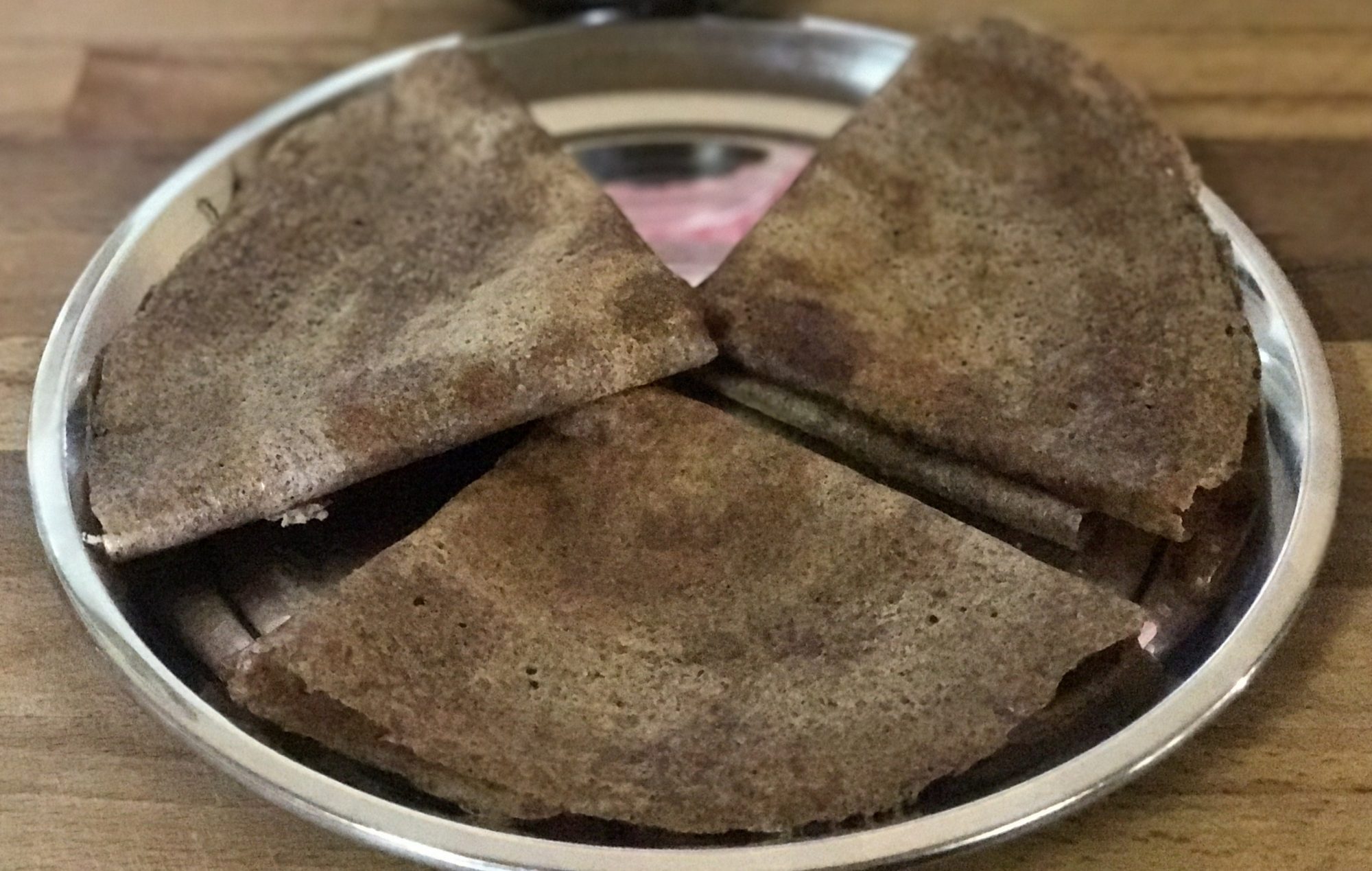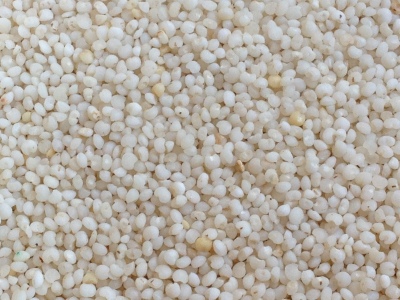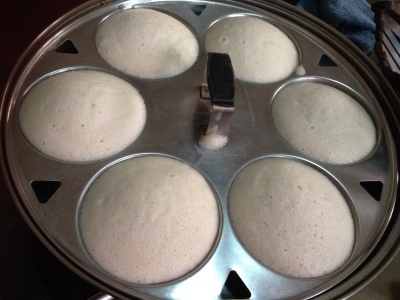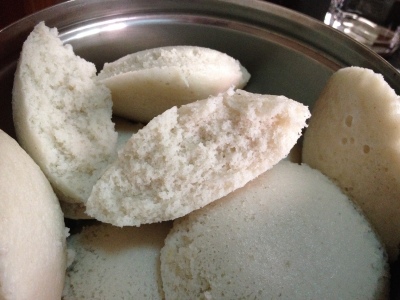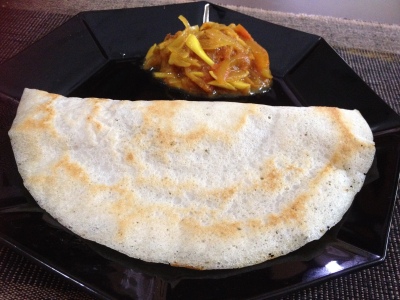The next power packed pancake is Varagarisi Dosai. Varagarisi is Kodo millet in English.
Scientific name – Paspalum scrobiculatum L.
varagu/kodo in close up
Kodo millet was domesticated in India almost 3000 years ago. It is found across the old world in humid habitats of tropics and subtropics. It is a minor grain crop in India and an important crop in the Deccan plateau.
The fiber content of the whole grain is very high. Kodo millet has around 11% protein, and the nutritional value of the protein has been found to be slightly better than that of foxtail millet but comparable to that of other small millets. As with other food grains, the nutritive value of Kodo millet protein could be improved by supplementation with legume protein. http://www.icrisat.org/crop-kodomillet.html
Points that struck me while searching for true facts on the ‘Goodness of Millets’ –
Millets are also unique due to their short growing season. They can develop from planted seeds to mature, ready to harvest plants in as little as 65 days. This is important in heavily populated areas. When properly stored, whole millets will keep for two or more years.
Unlike rice and wheat that require many inputs in terms of soil fertility and water, millets grow well in dry regions as rainfed crops. By eating millets, we will be encouraging farmers in dryland areas to grow crops that are best suited for those regions. This is a step towards sustainable cropping practices where by introducing diversity in our diets, we respect the biodiversity in nature rather than forcefully changing cropping patterns to grow wheat and rice everywhere. http://millets.wordpress.com/millets/
Health benefits of millets
- Regular consumption of millet is very beneficial for postmenopausal women suffering from signs of cardiovascular disease, like high blood pressure and high cholesterol levels.
- Children’s intake of whole grains like millet and fish has been shown to reduce the occurrence of wheezing and asthma.
- A high source of fiber, millet is very beneficial against breast cancer in post-menopausal women.
- According to research and recent studies, consumption of millet can help women combat the occurrence of gallstones, as they are a very high source of insoluble fiber.
- This form of cereal grain is very high in phosphorus content, which plays a vital role in maintaining the cell structure of the human body. The key role of this mineral is that it helps in the formation of the mineral matrix of the bone and is also an essential component of ATP (adenosine tri-phosphate), which is the energy currency of the body.
- A single cup of millet provides around 24.0% of the body’s daily phosphorus requirement. This mineral is a very important constituent of nucleic acids, which are the building blocks of genetic code.
- Recent research has indicated that the regular consumption of millet is associated with reduced risk of type 2 diabetes mellitus. This is mainly due to the fact that whole grains like millet are a rich source of magnesium, which acts as a co-factor in a number of enzymatic reactions in the body, regulating the secretion of glucose and insulin.
- Magnesium is also beneficial in reducing the frequency of migraine attacks. It is even very useful for people who are suffering from atherosclerosis and diabetic heart disease.
- To get the health benefits of millet, serve it warm with milk as an alternative to hot oatmeal in the morning. Its nutty taste can be enhanced by gently roasting the grains in a pan on the stovetop.
- It can also be popped like popcorn to create a healthy “puffed” cereal. It can be ground into gluten-free flour and added to baked goods. One can also use it in soups, casseroles, and as a side-dish in place of rice. Enjoy the many health benefits millet has to offer!
http://www.ilsi-india.org/conference-on-processed-foods-and-beverages-for-health/Session-IV/Prof-Suresh-Prasad-Delhi-Conf-on-millets-presentation.pdf
ALL MILLET VARIETIES SHOW HIGH ANTIOXIDANT ACTIVITY
At the Memorial University of Newfoundland in Canada, a team of biochemists analyzed the antioxidant activity and phenolic content of several varieties of millet: kodo, finger, foxtail, proso, pearl, and little millets. Kodo millet showed the highest phenolic content, and proso millet the least. All varieties showed high antioxidant activity, in both soluble and bound fractions.
Journal of Agricultural and Food Chemistry, 9 June 2010; 58(11):6706-14. http://wholegrainscouncil.org/node/7722/print
Varagu/Kodo Millet could be enjoyed in different forms and preparations. Varagarisi Idli/Rice Cakes, Varagarisi Dosai/Pancakes, Varagarisi Kanji/Porridge, Varagarisi Upma and many more.
Varagarisi Dosai/Kodo Millet Dosai
Kodo millet is a nutritious grain and a good substitute to rice or wheat. The grain is composed of 11% of protein, providing 9 grams/100 g consumed. It is an excellent source of fibre at 10 grams (37-38%), as opposed to rice, which provides 0.2/100 g, and wheat, which provides 1.2/100 g. An adequate fibre source helps combat the feeling of hunger. Kodo millet contains 66.6 g of carbohydrates and 353 kcal per 100 g of grain, comparable to other millets. It also contains 3.6 g of fat per 100 g. It provides minimal amounts of iron, at 0.5/100 mg, and minimal amounts of calcium, and 27/100 mg. Kodo millets also contain high amounts of polyphenols, an antioxidant compound. http://en.wikipedia.org/wiki/Paspalum_scrobiculatum
Ingredients (makes approximately 20-25 dosais) make half the quantity to make 10-12 dosais
- varagarisi /kodo millet – 4 cups
- ulundham paruppu/dehusked black gram – 1 cup
- vendhayam/fenugreek seeds – 1 tsp
- uppu/salt – as needed approx. 1 tsp to 1 1/2 tsp
- oil – to make dosai
Note:
- Unlike the previous Dosais with finger millet and pearl millet, here kodo millet batter is made exactly like the normal Idli/dosai batter
- Dehusked black gram is soaked separately with fenugreek seeds and the millet is soaked separately. The gram and fenugreek remains the same; rice is replaced with varagarisi/kodo millet.
- Though I have not tried Kezhvaragu/finger millet or Kambu/pearl millet idly, I made varagarisi/Kado millet Idlies, which were soft and fluffy and tasted only a tiny bit different from normal Idlies.
- It is highly recommended to have a glass of more/buttermilk to reduce the heat effects of this millet.
varagarisi idli/kodo millet steamed cakes
fluffy and soft
Method of Preparation
- Wash and Soak kodo millet
- Wash and soak black gram and fenugreek seeds
- Soak the ingredients separately in enough water for a minimum 6 hrs
- Grind the black gram-fenugreek combination to a smooth and fluffy consistency
- Remove from the grinder/blender and grind the soaked millet to a fine paste
- Mix both with enough salt and leave the batter to ferment for 8 hrs or overnight
- In a warm country, 8 hrs is enough and one can mix the fermented batter and keep it refrigerated for further use
- Once fermented, always keep the batter refrigerated as it will go sour and get spoilt
- Make hot Dosais and serve with vengaya thuvayal /onion chutney or any chutney of choice
- After the dosais, more/buttermilk which is the diluted version of yoghurt with salt is served as coolant
- The buttermilk aids in digestion.
